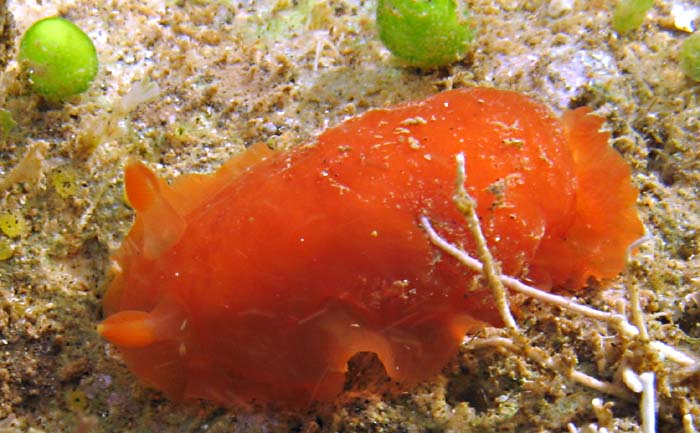This species has been observed on Reunion and Mayotte Islands
Species characteristics : There are two color forms, a grey form, and a orange/red form. They often have large blackish patches on a lighter background. The five or six, large, complex gills form a complete circle around the anus. They are often spread from one side of the mantle to the other. |

|
|
| Showing species characteristics... | Photo Hugues Flodrops Réunion, Etang salé on the rocky coast, less 1 m, 16 April 2007 during the night, size : 85 mm |
|
See more about : Sightening and mating periods
See more about : Dendrodoris fumata variability in Southwest Indian ocean
Remarks :
Identification confirmed by Bill Rudman
In Reunion Island we have only found orange/red specimens...If you have taken a photo of the other color form, please Contact us...
Synonymous (according worms) :
- Actinodoris tilesii Gray, 1850 - Doridopsis rosea Vayssiére, 1912
- Dendrodoris erubescens (Bergh, 1905) - Doris atrata Kelaart, 1858
- Dendrodoris rubra (Kelaart, 1858) - Doris fumata , Rüppell & Leuckart, 1830
- Doridopsis communis Risbec, 1928 - Rostanga atrata (Kelaart, 1859)
- Doridopsis rubra (Kelaart, 1858)
- Doridopsis erubescens (Bergh, 1905)
Bibliographic data :
There are two color forms, a grey form and a orange/red form :
- The grey form has a translucent grey mantle which sometimes has irregular grey patches in the center.
- The orange/red form has an orange reddish mantle with is invariably speckled with brown, the rhinophores have a pale orange stalk and burnt orange clavus with a white tip and the gills are uniformly orange
It feeds on siliceous sponges. In coastal northern Queensland, the food has been identified asTedania aff. ignis (family Tedaniidae). Like other Dendrodoris, it's a suctorial sponge-feeding.
External differences between between the two similar species : D. nigra and D. fumata :
- D. nigra is more elongate when crawling than D. fumata
- In D. nigra the gills are relatively numerous (10 or more short gills which stand quite upright) and form a compact circle around the anus at the extreme posterior end of the dorsum . In D. fumata there are only 5 or 6 spreading gills which are relatively large, which often spread from one side of the mantle to the other, and attached further forward.
One internal character clearly separates the two species :
- In D. nigra there is an accessory gland at the genital opening which is absent in D. fumata.
Rachel Przeslawski observation : D. nigra and D. fumata laid in the laboratory a thin upright spiral orange egg ribbons with some differences :
D. nigra
looser "messier" spiral mass
egg ribbon
(5.5-6 mm)high density of embryos very tightly packed
eggs and capsules
(125 µm, 175 µm)there was only 1 egg per capsule with occasional twins
D. fumata
neatly coiled
massegg ribbon
(3-5 mm)only had 2 layers of embryos in moderate density
eggs and capsules
(75 µm, 100 µm)
References :
Bill Rudman Seaslug site : Sea Slug Forum : Dendrodoris fumata
Nudipixel Dendrodoris fumata
Publications :
Brodie, G. D., Willan, R. C. & Collins, J. D. 1997. taxonomy and occurrence of Dendrodoris nigra and dendrodoris fumata (Nudibranchia: Dendrodorididae) in the Indo_west Pacific region. Journal of Molluscan Studies 63: 407-423.
Ruppell, W.P.E.S. & Leuckart, F.S. (1831 for 1828). Mollusca. In Atlas zu der Reise im nördlichen Afrika von Eduard Rüppell Zool. Neue wirbellose Thiere des Rothen Meers : 15-47, pls. 1-12
Other photos of Dendrodoris fumata :
Hugues Flodrops Réunion, Etang salé on th rocky coast, less 1 m, 16 April 2007during the night, size : 85 mm
The orange/red form has an orange reddish mantle with is invariably speckled with brown, the rhinophores have a pale orange stalk and burnt orange clavus with a white tip.
|
 |
 |
The five or six, large, complex gills form a complete circle around the anus. They are often spread from one side of the mantle to the other.
|
 |
Hugues Flodrops Réunion, Etang salé on the rocky coast, less 1 m, 27 November 2007, size : 75 mm. A orange/red form. More red than oange... |
Hugues Flodrops Réunion, Etang salé on the rocky coast, less 1 m, 5 May 2007, size : 60-65 mm. Near surface (butterfly reflection) during another night |  |
 |
Christophe Cadet Réunion, Etang salé on the rocky coast, less 1 m, 19 October 2009, size : 35 mm. The genital aperture (a) on the right side of this Dendrodoris.  |
|
In D. fumata there are only 5 or 6 spreading gills which are relatively large, which often spread from one side of the mantle to the other An orange form without large blackish patches |
 |
 |
Eva Fontaine Mayotte, Tahiti plage, less 1 m, 25 July 2008, size : 30 mm An orange form without large blackish patches like Christophe Cadet specimen from Réunion Island. |
Eva Fontaine Mayotte, "Gombé Ndroumé", less 1 m, 12 December 2011, size : 6-8 mm
A juvenile... |
 |
 |
Seb Vasquez Réunion, Etang salé on the rocky coast, less 1 m, 22 November 2014
Original specimen, especially red with a white margin ... |
More photos from Indian Ocean
See more about : Dendrodoris fumata variability in Southwest Indian ocean
Reunion, orange form of Dendrodoris fumata, at Etang salé, by Christophe Cadet
Mayotte, two orange form of Dendrodoris fumata, at Jimaweni, by Philibert Bidgrain
Mayotte, D. fumata orange form with large brownish patches, at Petite Terre, by Matthias Deuss
